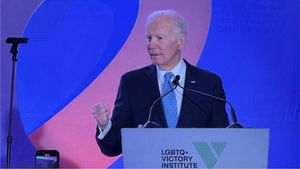Scientists at the The Scripps Research Institute were just awarded nearly $6 million from the Bill & Melinda Gates Foundation to develop a genetically engineered HIV vaccine that has shown potential in animal models. The approach works by coaxing muscle cells into producing inhibitor proteins that block key sites on the virus’s surface used to attach and invade human immune cells—fooling the virus into thinking it is binding to a human cell. Unable to attach to cells, and unable to reproduce, the virus simply floats impotently in the blood stream. Research on the drug, eCD4-Ig, shows it's the "broadest and most potent entry inhibitor described so far, effective against all strains tested,” according to lead researcher professor Michael Farzan. “At the end of our research, we expect to have enough evidence to develop a firm foundation to fully evaluate its potential as an alternative vaccine.”
The announcement comes on the heels of a new study published this week in the journal Cell , which reveals that it can take a hundred years and thousands of researchers before a cure is found for a particular disease.
As Dawn Ennis explains in this article on how a drug makes it to market, there is a step by step process that happens between the development of a breakthrough treatment and when it becomes available at your local pharmacy. Unfortunately, the actual development of a drug is rarely that straightforward, simple or precise. This new study reveals just how incredibly long, arduous, convoluted, and even haphazard the road to a curative therapy can be.
Researchers at the Gladstone Institutes, the nonprofit biomedical research arm of UCSF, went back in time, tracing the path to discovery for two drugs recently approved by the Food and Drug Administration (FDA). The first is Ivacaftor, (also known as Kalydeco) the first medication to effectively treat underlying cause of cystic fibrosis; and ipilimumab, also known as Yervoy, an immune therapy that’s dramatically increased the survival rates for some patients with metastatic melanoma.
Looking at published citations and other references they call "bibliometrics," the researchers deciphered the incremental scientific advances that eventually led to the development of those two medications.
They traced ipilimumab back a 100 years and found it was the result of work conducted by 7,000 scientists at 5,700 institutions. The other drug, Ivacaftor, involved the research of 2,900 scientists affiliated with 2,500 institutions over the course of 60 years.
Even the people doing this archeological dig into the drugs’ histories were surprised what they unearthed.
"We were surprised," acknowledged Alexander Pico, Gladstone's associate director of bioinformatics, speaking to The Washington Post. He added that their work showed a "large and complex network" of individuals and institutions contributed to the development of these – and maybe all -- drugs. "It’s more of a collective endeavor... It really does take this network of individuals over a long time to lay the foundation."
Still, Pico said, not every cog in the wheel is of equal importance. They found that specific scientists played outsized roles in the steps toward the final, successful development. Researchers dubbed these scientists "elite performers," much like the “elite controllers” (like this California woman) who are uniquely resistant to the negative impacts of HIV). In other words, the elite performers can move the drug forward in leaps compared to the small steps of their colleagues.
"We’re not claiming that every paper in this network has a direct and obvious connection to the final drug," Pico added. "But that’s also kind of the point -- that basic research has to explore peripheral topics in order to narrow down and lead to the final drug development. It takes exploratory research on a wide range of topics."
Pico told The Post that he hopes the Gladstone project will, remind people just how important scientific research is; and why it should be seen as an investment for governmental spending. He said the ultimate goal of this work is to a set of "predictive" metrics that could illuminate which research, institutions or scientists to fund to speed up the development of new drugs and treatment therapies.
What does all this mean for an HIV cure? As the October issue of Poz puts it, “The Cure For HIV Is Not Around the Corner.” Rsearchers have been working on the problem for over three decades and have had many breakthroughs, but key scientists still admit that a cure for HIV isn’t going to happen anytime soon. (Read more about why it’s so hard here).
Still, we are closer than ever to understanding exactly what needs to happen for a person with HIV to be cured (for example, using antiretroviral treatment to suppress the viral load, then employing a kick and kill strategy to target hidden reservoirs of the virus, before employing a vaccine to protect from future infections).
In other words, don't hold your breath, but don't give up either. A cure is coming. It just may take another decade.








































































